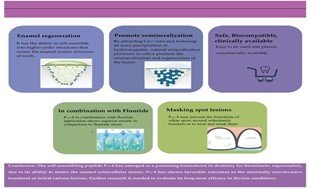
Self-assembling peptide P11-4 has garnered significant attention in the field of dentistry due to its remarkable effectiveness in promoting dental hard tissue regeneration. P11-4 is a synthetic biomaterial composed of short peptides that can spontaneously assemble into nanofibrous scaffolds, mimicking the extracellular matrix structure in teeth. This self-assembly property allows P11-4 to provide a supportive environment for dental tissue repair.
MODE OF ACTION
The ẞ-sheet-forming peptides, P11-4, that self-assemble themselves the to form three-dimensional scaffolds under defined environmental conditions have been shown to nucleate hydroxyapetite. The anionic groups of the P11-4 side chains attract Ca++ ions, inducing the precipitation of HAP in situ. Self-assembly of these structures can result in the formation of nanostructures, including nanofibers, nanotubes, and nanovesicles.

APPLICATIONS
Early enamel caries remineralization
The peptide self-assembles into a viscous fibrous scaffold under the influence of the circumstances seen in a carious environment. The anionic groups in peptide P11-4 attract calcium ions and can precipitate hydroxyapatite crystals from scratch. The nucleator pulls ions out of tissue fluids and organises them into a crystalline structure.


Orthodontic treatment- induced caries
Demineralisation can occur near brackets during fixed orthodontic treatment. Early enamel alterations may progress, and WSLs may arise if appropriate preventative strategies are not used. . They came to the conclusion that the mineral gain effectiveness of fluoride varnish is superior to the one-time application of fluoride varnish. The benefit is that it improves enamel remineralisation, which is especially important in these patients because fluoride alone may not be enough. As a result, preparation of the enamel surface with P11-4 peptide prior to bracket insertion is a viable option.
Hypersensitivity of the dentin
Dentine hypersensitivity (DH) is widely believed to occur as a result of fluid flow within exposed dentinal tubules in the tooth surface. Most treatments are designed to occlude these tubules. Due to hydroxyapatite binding sites, the self-assembling peptide P11-4 has a high affinity for the dentinal surface. As a result, electrostatic interactions bind the matrix to the tooth, due to which the dentinal tubules are occluded, and dentinal hypersensitivity is reduced due to these interactions.


No Any Replies to “EFFECTIVENESS OF SELF ASSEMBLING PEPTIDE (P11-4) IN ENAMEL REMINERALIZATION”
Leave a Reply